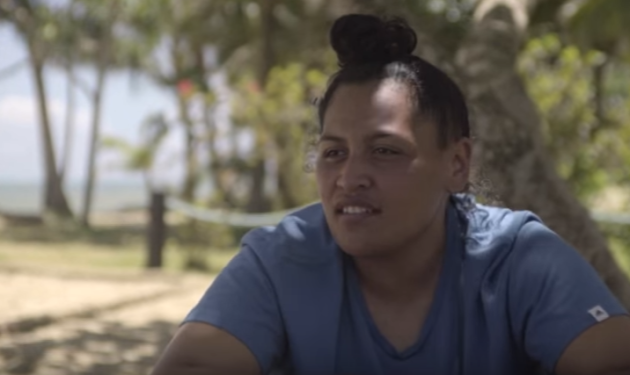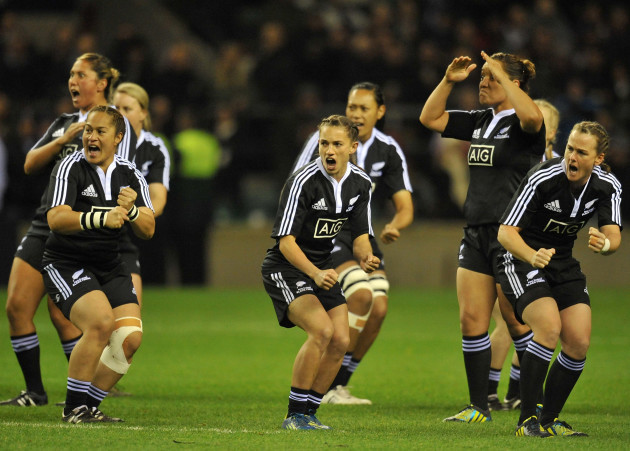EFFORTS TO LEARN a little more about ancient faraway cultures don’t always bring you where you expect them to.
“Do you know Dragonball Z?
“There’s a move called the spirit bomb that Goku does,” says Te Kura Ngata-Aerengamate – TK to her friends -, veering from a territory her interviewer knew little to one he knew nought of.
“He puts his hands in the sky and gathers all of the life force around him and creates a massive powerball.”
Along with being a versatile Black Fern (capable of operating in both front and back rows) en route to Ireland for this month’s Women’s Rugby World Cup, Ngata-Aerengamate is a PE and Māori language teacher in Tangoroa College, where former World Cup-winning Black Fern Davida White is principal.
The Dragonball touch-point merely offers an example of what New Zealand teams feel they get from performing their haka.
Kiwi teams performing their pre-match ritual always makes for intriguing viewing, and after falling to Ireland and failing to make the semi-finals at the 2014 World Cup, supporters will see plenty of intent in the Black Ferns when they perform the Ko Uhia Mai in Belfield and Belfast this month.
Just as the All Blacks have moved to vary their haka from Ka Mate to Kapo o Pango in this century, the Black Ferns have changed their signature cultural challenge (as World Rugby call them) to better represent a united Aotearoa.
The previous incarnation of the women’s haka, Ka Panapana, was dispensed with, TK explains, as it represented just one of New Zealand’s Iwi (tribes or, more literally, bone). It belonged to the Iwi Ngati Porou, the second-largest tribe by population, but still just one of 99. Consider it a parallel to Ireland rolling out The Rose of Tralee as their anthem at the 1987 World Cup.
In place of the old haka, Ko Uhia Mai was written for the national women’s team by Whetu Tipiwai.
“The leader calls out to the girls: ‘Ko nga Mamaku o Aotearoa Kia mau!’
Mamaku, is the Maori word for Black Ferns, it’s part of the silver ferns. Each one branches off the middle.”
In brief, the words call on the players to be ready and proclaim their identity, but the symbolism is as important as the words themselves.
“It’s about who we are. It’s about the three Goddesses of Māori culture and tradition. They’re like the wonder women of our culture,” explains Ngata-Aerengamate, before listing the mythical figures: Hineahuone (the first woman), Hinetitama (daughter of Hineahuone) and Hine Nui Te Po (Goddess of night and death) that feature in the second verse.
“They’re like women of life in our myths and legends. We bring them onto the field in battle. We talk about life forces in our haka. Our people are quite spiritual. We like to relate ourselves to our land, mountains and oceans. We also talk about how we treasure that.”
“We talk about our mountains, where we get our streams from, what grounds us is the land and our oceans. We also talk about us and women of strength, that will go out there and fight.
“We talk about standing together as one, the wonder women in our culture and how we gather all our energy from our families, our land and what surrounds us here in Aotoroa.”
Ko Uhia Mai *
A uhia mai
Let it be known
Ko wai nga Hine
Who are these women
Ko wai nga Hine
Who are these women
Ko nga Mamaku e ngunguru nei
It’s the Black Ferns rumble
Ko Hineahuone, Ko Hinetitama Ko Hinenui te po
From Hineahuone, Hinetitama and Hinenui te po we came
Ki te whaiao, ki te ao marama e
To transfer from the heavens to the world of enlightenment
Hi a hahaMauri ki te rangi
Life force from above
Me te whenua
Life force from below (earth)
Nga kapua whakapipi
The gathering clouds
Mai nga Maunga titia e
The mountains that pierce the sky
Hi a hahaHe tia he tia
Let us proceed.
Te Moana nui–a–Kiwa
To the seas.
Mai nga topito
From the corners of the island.
Ki nga moutere
To the neighbouring islands.
O te ao whanui e
And around the world.Hi a haha
Tumai ra koe
You stand tall and proud.
Te mana wahine
Women of strength.
Te Wharetangata
Who will bear the future.
Nga Mamaku o Aotearoa
The Black Ferns of New Zealand.He tia he tia. He ranga he ranga
Rise and press on.
Haere mai te toki
When the challenge arrives.
Haumi ee, hui e
We will gather and unite together.
Taiki ee
Strength together. It will be done.
Hi!
This month in Ireland, Ngata-Aerengamate will lead the haka calls right from the heart of her team’s formation, just as she was in the thick of one very special haka which was performed behind closed doors in June. Thankfully, the All Blacks opted to broadcast the challenge via the below video.
In Rotorua, the bubbling hot spring that is a heart of Māori culture, the Ferns performed Ko Uhia Mai in tandem with a chilling Māori All Black haka in a vibrant clash of challenges before their respective matches against England and the Lions.
“We had a togetherness with our Māori rugby team which we were lucky to have. We don’t really cross paths with our men’s team and being Māori it was really good to perform with a Māori team and get that heightened sense of being at home.”
The subsequent results didn’t go right for either side, but nobody has ever claimed the haka is a disadvantage to New Zealand teams. Quite the opposite. Where most only ever think of a ‘second wind’ as coming midway through the first half, Kiwis want to feel it from their haka, even before the first whistle goes.
“It’s just what gets us going before a battle. Our traditional haka is used to hype soldiers at war. It gets us going, gives us our second wind before our games.
“We try to get that second wind through the haka, get it faster. You can get it when you’re playing a game, but we try and get it before the game. The haka really really helps us get hyped up.
“It also assures us that the people beside us have got our backs as well, unity and togetherness as a squad.”
The42 is on Instagram! Tap the button below on your phone to follow us!
*Translation of Ko Uhia Mai sourced and adapted from here; first published 16.00, 1 August


